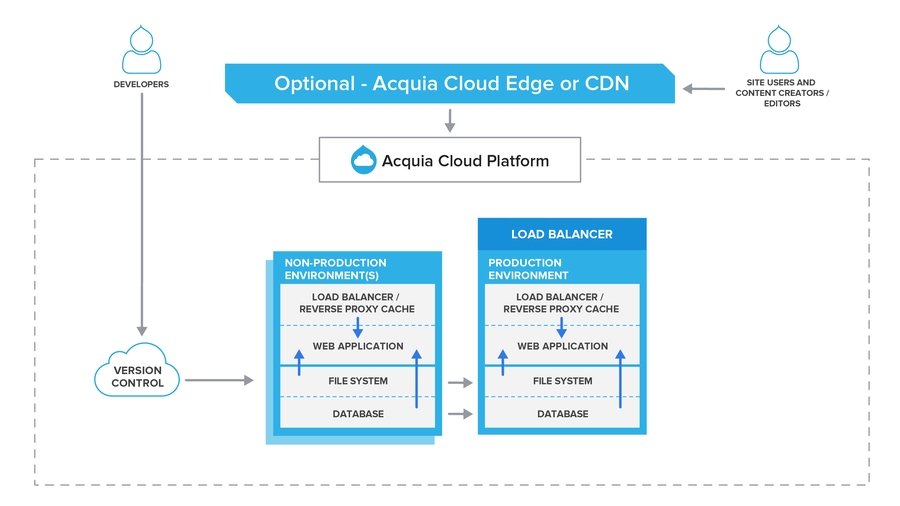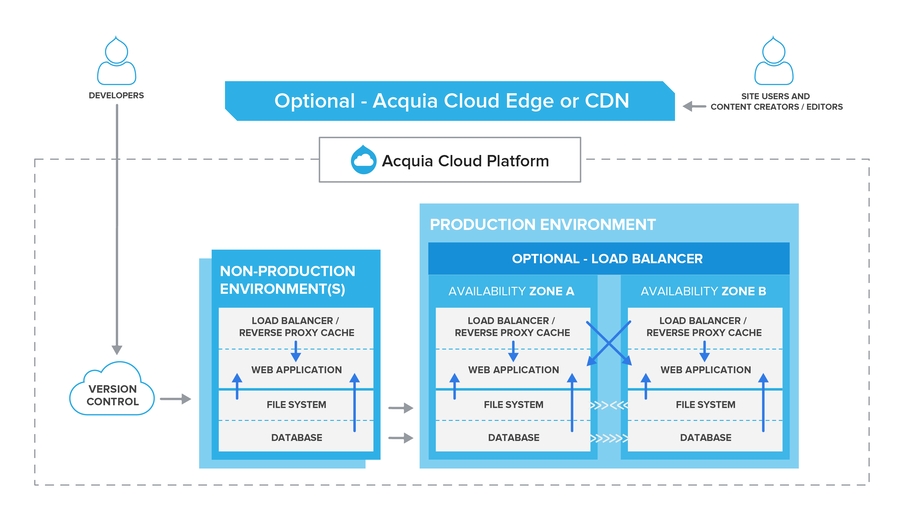Study Guide
General Overview of Cloud Platform
This video will provide an overview of the Cloud Platform user interface. The resources within each domain will help you investigate each topic in more depth.
Study Guide by Domain
Domain 1.0: Fundamental Web Hosting Concepts
1.1 Demonstrate knowledge of basic web hosting architecture
A Cloud Pro understands basic website hosting architecture.
Resource:
1.2 Demonstrate knowledge of Drupal development workflows
A Cloud Pro should know how to set up workflows for Drupal development on Cloud Platform that follow best practices, avoid regression issues, and maintain secure code.
Resources:
1.3 Demonstrate knowledge of key security and performance concepts
A Cloud Pro should know about basic security and performance concepts in Drupal and Cloud Platform, as well as how to identify when an application does not conform to best practices.
Resources:
Domain 2.0: Cloud Platform Features and Interface
2.1 Demonstrate understanding of key features of Cloud Platform
A Cloud Pro understands the key features and user interface of Cloud Platform, including basic service levels of Cloud Platform Professional and Cloud Platform Enterprise.
Resources:
2.2 Demonstrate ability to configure various aspects of an environment
A Cloud Pro should be able to configure an environment appropriate for team development of an application, including modifying PHP settings, entering Sendmail path for an application, and enabling or disabling Varnish over SSL.
Resource:
2.3 Demonstrate ability to configure teams and users
A Cloud Pro should be able to set up a team and its users within Cloud Platform, including assignment of roles, creating custom roles, and administering permissions. Also included is the management of an Organization within Cloud Platform.
Resources:
Domain 3.0: Drupal Development workflow on Cloud Platform
3.1 Demonstrate ability to install a new Drupal site on Cloud Platform
A Cloud Pro should be able to install a new Drupal site on Cloud Platform by creating a new application, importing an existing application, or installing a Drupal distribution.
Resources:
3.2 Demonstrate ability to set up a local development environment for working with Cloud Platform
A Cloud Pro will be able to set up a local development environment.
Resources:
3.3 Demonstrate ability to deploy code, database, and files to various environments
A Cloud Pro will be able to deploy code, database, and files to various environments on Cloud Platform, using a workflow that follows best practices.
Resources:
3.4 Demonstrate ability to manage Drupal site configurations across various environments
A Cloud Pro will be able to manage site configurations for a Drupal application across environments.
Resources:
3.5 Demonstrate ability to use Cloud API for workflow automation
A Cloud Pro will be able to use the Acquia Cloud Platform API to automate workflows for development, authentication, drush and cloud hooks.
Resources:
Domain 4.0: Cloud Platform Best Practices
4.1 Demonstrate understanding of best practices for performance enhancement
A Cloud Pro will understand best practices for performance enhancement of Drupal applications, including basic application performance, Drupal performance, and maintaining the required level of performance for your application.
Resources:
4.2 Demonstrate understanding of security best practices
A Cloud Pro will understand security best practices related to access control, managing team members and permissions, and whitelisting.
Resources:
4.3 Demonstrate understanding of best practices for Live Deployment
A Cloud Pro will understand the best practices related to live deployment, including basic tools, live code changes, and workflow.
Resources:
Additional Resources
The following are additional resources provided for your supplemental learning and practice.
Cloud Platform infrastructure
The Cloud Platform architecture and key concepts section of the Cloud Platform documentation describes how Cloud Platform works, including information about Cloud Platform's architecture, security, high availability features, and compliance with standards and regulations.
As indicated in the two diagrams below, there are four main components for both Cloud Platform Enterprise and Cloud Platform Professional applications:
Reverse proxy caching and load balancing servers - Varnish/nginx
Web servers - Apache with PHP and Drupal code
Database servers - MySQL (Percona)
Network file system - (GlusterFS)
The exact configuration of an Cloud Platform application's infrastructure depends on several factors, including whether the application is part of Cloud Platform Enterprise or Cloud Platform Professional.
Cloud Platform Enterprise infrastructure diagram
Cloud Platform Professional infrastructure diagram
Acquia Site Factory infrastructure diagram
The Acquia Site Factory and Cloud Platform section of the Cloud Platform documentation describes the supported and included features of Acquia Site Factory, which is built upon Cloud Platform Enterprise.
Cloud Platform videos in Acquia Academy
Caching and Varnish
Learn more about the Acquia Certification Program at https://acquia.com/certification.
Last updated



